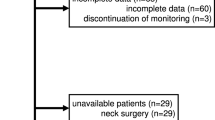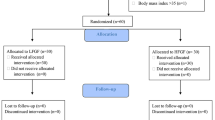Abstract
Purpose
To study the incidence and severity of nocturnal episodic hypoxemia after ambulatory breast cancer surgery and its differences with sevoflurane and propofol anesthesia.
Methods
Sixty-one adult female patients (ASA PS I–II; age, 32–77 years) without an apparent history of sleep apnea and respiratory disease undergoing major breast cancer surgery on an outpatient basis and with planned overnight admission were randomized to one of two anesthesia maintenance groups: sevoflurane anesthesia (SEV, n = 31) or intravenous propofol, fentanyl, and vecuronium anesthesia (TIVA, n = 30). All patients were administered propofol 2 mg·kg−1 intravenously for anesthesia induction, had a laryngeal mask airway placed, and received rectal diclofenac and local infiltration anesthesia for pain relief. No opioid analgesic or oxygen was administered after discharge from the postanesthesia care unit (PACU). Oxygen saturation (SpO2) was recorded continuously during the first postoperative night. SpO2 <90% that lasted >10 s was regarded as hypoxemia, and the percentage of effective recording time with SpO2 <90% (%time with SpO2 <90) was evaluated.
Results
Six patients (SEV3/TIVA3) had >1% of %time with SpO2 <90 (S-hypoxemia group), 17 (SEV7/TIVA10) had >0% and ≤1% (M-Hypoxemia group), and 38 (SEV21/TIVA17) had 0% (no-hypoxemia group). There were no statistical differences in age, ASA PS, anesthesia technique, and duration of anesthesia among groups. The S-hypoxemia group had higher body mass index (BMI) and incidence of oxygen supplementation in the PACU than the no-hypoxemia group. No patient had major complications.
Conclusion
Nocturnal episodic hypoxemia occurs frequently after ambulatory breast cancer surgery. The incidence was not different between SEV and TIVA. Hypoxic patients had a higher BMI and needed oxygen therapy in PACU more frequently.
Similar content being viewed by others
References
TW Feeley A Macario (2005) The postanesthesia care unit RD Miller (Eds) Miller's anesthesia EditionNumber6th edn. Elsevier Churchill Livingstone Philadelphia 2703–2727
J Rosenberg H Kehlet (1997) Late postoperative hypoxemia JM Kinney HN Tucker (Eds) Physiology, stress and malnutrition: functional correlates, nutritional intervention Lippincott-Raven New York 183–206
JH Eichhorn (1998) ArticleTitlePulse oxymetry monitoring and late postoperative hypoxemia on the general care floor J Clin Monitor Comput 14 49–55 Occurrence Handle1:STN:280:DyaK1c3otF2htQ%3D%3D
H Kehlet J Rosenberg (1995) ArticleTitleLate post-operative hypoxemia and organ dysfunction Eur J Anaesth 12 IssueIDsuppl 10 31–34
T Pedersen (2005) ArticleTitleDoes perioperative pulse oximetry improve outcome? Seeking the best available evidence to answer the clinical question Best Pract Res Clin Anaesth 19 111–123
DM Catley C Thornton C Jordan JR Lehane D Royston JG Jones (1985) ArticleTitlePronounced, episodic desaturation in the postoperative period: its association with ventilatory pattern and analgesic regimen Anesthesiology 63 20–28 Occurrence Handle1:STN:280:BiqB2cbksVU%3D Occurrence Handle4014768
J Rosenberg WE Dirkes H Kehlet (1989) ArticleTitleEpisodic arterial oxygen desaturation and heart rate variations following major abdominal surgery Br J Anaesth 63 651–654 Occurrence Handle1:STN:280:By%2BC383ktFw%3D Occurrence Handle2611065
WG Brose SE Cohen (1989) ArticleTitleOxyhemoglobin saturation following cesarean section in patients receiving epidural morphine, PCA, or im meperidine analgesia Anesthesiology 70 948–953 Occurrence Handle1:CAS:528:DyaL1MXktlemtLo%3D Occurrence Handle2729636
RG Wheatley ID Somerville DJ Sapsford JG Jones (1990) ArticleTitlePostoperative hypoxaemia: comparison of extradural, i.m. and patient-controlled opioid analgesia Br J Anaesth 64 267–275 Occurrence Handle1:STN:280:By%2BB38npt10%3D Occurrence Handle2328174
J Rosenberg MH Pedersen P Gebuhr H Kehlet (1992) ArticleTitleEffect of oxygen therapy on late postoperative episodic and constant hypoxaemia Br J Anaesth 68 18–22 Occurrence Handle1:STN:280:By2C2Mzlslw%3D Occurrence Handle1739560
MK Reeder MD Goldman L Loh AD Muir P Foëx KR Casey PJ Mckenzie (1992) ArticleTitlePostoperative hypoxaemia after major abdominal vascular surgery Br J Anaesth 68 23–26 Occurrence Handle1:STN:280:By2C2Mzlsl0%3D Occurrence Handle1739561
L Beydon J Hassapopoulos M-A Quera A Rauss J-P Becquemin F Bonnet A Harf F Goldenberg (1992) ArticleTitleRisk factors for oxygen desaturation during sleep, after abdominal surgery Br J Anaesth 69 137–142 Occurrence Handle1:STN:280:ByyD3c7psVM%3D Occurrence Handle1389815
J Rosenberg H Kehlet (1993) ArticleTitlePostoperative mental confusion: association with postoperative hypoxemia Surgery (St. Louis) 114 76–81 Occurrence Handle1:STN:280:ByyA283gvVQ%3D
J Rosenberg T Ullstad J Rasmussen FP Hjørne NJ Poulsen MD Goldman (1994) ArticleTitleTime course of postoperative hypoxaemia Eur J Surg 160 137–143 Occurrence Handle1:STN:280:ByuB2s7os1M%3D Occurrence Handle8003566
J Rosenberg P Oturai CJ Erichsen MH Pedersen H Kehlet (1994) ArticleTitleEffect of general anesthesia and major versus minor surgery on late postoperative episodic and constant hypoxemia J Clin Anesth 6 212–216 Occurrence Handle10.1016/0952-8180(94)90061-2 Occurrence Handle1:STN:280:ByuA3sfntFU%3D Occurrence Handle8060628
B Gentil A Lienhart B Fleury (1995) ArticleTitleEnhancement of postoperative desaturation in heavy snores Anesth Analg 81 389–392 Occurrence Handle1:STN:280:ByqA2cvgt10%3D Occurrence Handle7618733
LG Georgiou AN Vourlioti FI Kremastinou PS Stefanou AG Tsiotou MD Kokkinou (1996) ArticleTitleInfluence of anesthetic technique on early postoperative hypoxemia Acta Anaesthesiol Scand 40 75–80 Occurrence Handle1:CAS:528:DyaK28XhslaltLs%3D Occurrence Handle8904262
S Isono M Sha M Suzukawa Y Sho A Ohmura Y Kudo K Misawa S Inaba T Nishino (1998) ArticleTitlePreoperative nocturnal desaturations as a risk factor for late postoperative nocturnal desaturations Br J Anaesth 80 602–605 Occurrence Handle1:STN:280:DyaK1czls1yqsw%3D%3D Occurrence Handle9691862
JG Stone KA Cozine A Wald (1999) ArticleTitleNocturnal oxygenation during patient-controlled analgesia Anesth Analg 89 104–110 Occurrence Handle1:STN:280:DyaK1Mzhs1Knug%3D%3D Occurrence Handle10389786
JP Thompson JR Boyle MM Thompson PRF Bell G Smith (1999) ArticleTitleNocturnal hypoxaemia and respiratory function after endovascular and conventional abdominal aortic aneurysm repair Br J Anaesth 82 129–131 Occurrence Handle1:STN:280:DyaK1M3lslKquw%3D%3D Occurrence Handle10325849
H Kawai Y Tayasu A Saitoh K Ooyama Y Tanaka Y Minamiya J Ogawa (2005) ArticleTitleNocturnal hypoxemia after lobectomy for lung cancer Ann Thorac Surg 79 1162–1166 Occurrence Handle10.1016/j.athoracsur.2004.09.063 Occurrence Handle15797044
RG Margolese J-CM Lasry (2000) ArticleTitleAmbulatory surgery for breast cancer patients Ann Surg Oncol 7 181–187 Occurrence Handle1:STN:280:DC%2BD3c3ltVGjuw%3D%3D Occurrence Handle10791847
WC Dooley (2002) ArticleTitleAmbulatory mastectomy Am J Surg 184 545–549 Occurrence Handle10.1016/S0002-9610(02)01051-6 Occurrence Handle12488162
GJ McCarthy RK Mirakhur (1992) ArticleTitlePostoperative oxygenation in the elderly following general or local anaesthesia for ophthalmic surgery Anaesthesia 47 1090–1092 Occurrence Handle1:STN:280:ByyC2c3pt1Q%3D Occurrence Handle1489043
TA Bowdle (2004) ArticleTitleNocturnal arterial oxygen desaturation and episodic airway obstruction after ambulatory surgery Anesth Analg 99 70–76 Occurrence Handle15281506
JT Moller M Wittrup SH Johansen (1990) ArticleTitleHypoxemia in the postanesthesia care unit: an observer study Anesthesiology 73 890–895 Occurrence Handle1:STN:280:By6D2M3lt1c%3D Occurrence Handle2240679
G Shirakami Y Teratani T Namba H Hirakata M Tazuke-Nishimura K Fukuda (2005) ArticleTitleDelayed discharge and acceptability of ambulatory surgery in adult outpatients receiving general anesthesia J Anesth 19 93–101 Occurrence Handle10.1007/s00540-004-0297-6 Occurrence Handle15875124
J Rosenberg GI Rasmussen KR Wøjdemann LT Kirkeby LN Jørgensen H Kehlet (1999) ArticleTitleVentilatory pattern and associated episodic hypoxaemia in the late postoperative period in the general surgical ward Anaesthesia 54 323–328 Occurrence Handle10.1046/j.1365-2044.1999.00744.x Occurrence Handle1:STN:280:DyaK1MzosVOksw%3D%3D Occurrence Handle10455829
SS Jain R Dhand (2004) ArticleTitlePerioperative treatment of patients with obstructive sleep apnea Curr Opin Pulm Med 10 482–488 Occurrence Handle15510054
C Sabers DJ Plevak DR Schroeder DO Warner (2003) ArticleTitleThe diagnosis of obstructive sleep apnea as a risk factor for unanticipated admissions in outpatient surgery Anesth Analg 96 1328–1335 Occurrence Handle12707128
PF White AR Freire (2005) Ambulatory (outpatient) anesthesia RD Miller (Eds) Miller's anesthesia EditionNumber6th edn. Elsevier Churchill Livingstone Philadelphia 2589–2635
G Shirakami H Segawa T Namba T Shichino K Fukuda (2002) ArticleTitleOmission of fentanyl during sevoflurane anesthesia decreases the incidence of postoperative nausea and vomiting in female patients undergoing ambulatory breast cancer surgery Anesthesiology 97 A18
K Yunoki G Shirakami M Tazuke S Matsuura K Fukuda (2004) ArticleTitleComparison of sevoflurane anesthesia and propofol-fentanyl-vecuronium anesthesia for ambulatory breast cancer surgery Anesthesiology 101 A55
NE Farber PS Pagel DC Warltier (2005) Pulmonary pharmacology RD Miller (Eds) Miller's anesthesia EditionNumber6th edn. Elsevier Churchill Livingstone Philadelphia 155–189
Matsuura S, Shirakami G, Iida H, Tanimoto K, Fukuda K (2006) Effect of sevoflurane on ciliary motility in rat cultured tracheal epithelial cells: comparison with isoflurane and halothane. Anesth Analg (in press)
G Shirakami D Li X Zhan RA Johns (2000) ArticleTitlePropofol stimulates ciliary motility via the nitric oxide-cyclic GMP pathway in cultured rat tracheal epithelial cells Anesthesiology 93 482–488 Occurrence Handle1:CAS:528:DC%2BD3cXlvFelu7g%3D Occurrence Handle10910499
Iida H, Matuura S, Shirakami G, Tanimoto K, Fukuda K (2006) Differential effects of intravenous anesthetics on ciliary motility in cultured rat tracheal epithelial cells. Can J Anesth (in press)
Y Fujii H Tanaka H Toyooka (1996) ArticleTitleIntraoperative ventilation with air and oxygen during laparoscopic cholecyctectomy decreases the degree of postoperative hypoxaemia Anaesth Intens Care 24 42–44 Occurrence Handle1:STN:280:BymB3s3kvVI%3D
Author information
Authors and Affiliations
Additional information
This work was presented in part at the 6th International Congress of Ambulatory Surgery in Seville, Spain, and at the 52th Congress of the Japanese Society of Anesthesiologists in Kobe, Japan.
About this article
Cite this article
Shirakami, G., Teratani, Y. & Fukuda, K. Nocturnal episodic hypoxemia after ambulatory breast cancer surgery: comparison of sevoflurane and propofol-fentanyl anesthesia. J Anesth 20, 78–85 (2006). https://doi.org/10.1007/s00540-005-0371-8
Received:
Accepted:
Issue Date:
DOI: https://doi.org/10.1007/s00540-005-0371-8




